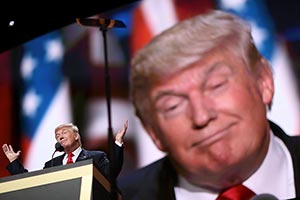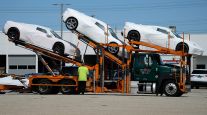Business Loves Trump But May Need Help to Start Spending Again

American companies are feeling confident again. Now it’s up to President-elect Donald Trump and Congress to get them spending again.
Sentiment from small firms to large manufacturers has rocketed to lofty heights since Trump was elected, mirroring brighter attitudes among consumers. But the true test for the economy now lies in the details and how quickly plans for deregulation, tax reform and infrastructure outlays come to fruition — and translate that confidence into investment.
The latest indicator, the National Federation of Independent Business’s small-business confidence index, surged in December to the highest level since 2004. Manufacturers and service providers in the Institute for Supply Management’s semiannual forecast also were upbeat about 2017. And consumer sentiment is the strongest since 2004.
The last time such widespread optimism prevailed, economic growth averaged 3% the following year and gains in capital spending ran at 5%. That’s a positive for the economy’s prospects, since business investment has been the clear laggard the past couple of years.
“The signals are certainly good,” said Joshua Shapiro, chief U.S. economist at Maria Fiorini Ramirez Inc. in New York.
The improved mood “is a first step. If businesses and consumers are feeling more confident, they’re more likely to do things which are beneficial economically,” she said.
Overall capital spending advanced 0.2% on average in the two years through the third quarter, while consumer spending climbed 3% and the economy grew at a 1.9% pace.
Trump’s economic agenda aims to bring growth to an average 3.5%.
Some solid pieces are already in place. Companies are hiring, the jobless rate is near a nine-year low and wage growth is picking up. What’s more, oil prices are starting to rise, encouraging a resumption of drilling, while a slump in manufacturing appears to have run its course.
The NFIB report on Jan. 10 showed 73% of the December advance was due to more upbeat views about the outlook for sales and the economy. The share of business owners who say now is a good time to grow is triple the average of the current expansion.
Still, “business investment may not pick up dramatically until some of the policy-related optimism is actually validated,” Stephen Stanley, chief economist at New York-based Amherst Pierpont Securities, said in a note.
Trump has vowed to ease regulatory burdens for businesses and swiftly repeal the Obama health-care law, which the NFIB has said is strangling small businesses. He has also pledged to reduce taxes and penalize firms that send production and jobs overseas.
“It’s a little early to say anything intelligent on U.S. tax policy or trade policy or infrastructure spending,” Michael Larsen, chief financial officer of Illinois Tool Works Inc., said at an investor meeting last month. While policy changes are likely to be positive, “when we know what the facts are, we’ll deal with that.”
In October 2004, President George W. Bush signed into law what was at the time the biggest overhaul of the corporate tax code since 1986, helping spur a 10.6% annualized gain in capital investment over the six quarters ending in early 2006, according to Joseph LaVorgna, chief U.S. economist at Deutsche Bank Securities Inc.
Among recent data, the Federal Reserve Bank of Philadelphia’s regional manufacturing gauge showed expectations for more capital expenditures are at an almost 17-year high, while the Dallas Fed’s report showed the share projecting higher investment is the biggest since 2007.
Housing may also deliver further progress, with the National Association of Home Builders/Wells Fargo builder sentiment index at an 11-year high.
“The Trump plan will prove even more stimulative for business investment, which is the linchpin” of forecasts for faster economic growth, LaVorgna said in a note.
The proof will be in the pudding.
“Hope has been booked, but has yet to be billed,” wrote Neil Dutta, head of U.S. economics at Renaissance Macro Research.
Ian Shepherdson, chief economist at Pantheon Macroeconomics Ltd., also cautioned that the small-business sentiment figures, while strong, are also volatile.
Other economic headwinds could hurt businesses’ propensity to invest. The Fed is gradually raising borrowing costs, while the dollar’s recent appreciation could restrain U.S. sales to overseas customers.
There’s also the question of Trump’s approach to trade. The President-elect has vowed to take a harder line against nations that manipulate their currencies to gain an unfair advantage in exporting to the U.S., and has threatened to tear up the North American Free Trade Agreement, without elaborating. That could result in tariffs on imports and retaliatory measures by other countries that would curb exports.
“There’s still enormous uncertainty,” Shapiro said.
Nonetheless, “the economy’s got a pretty good head of steam right now” and the better outlook is “feeding into sentiment and into expectations of what will occur,” Shapiro said.
With assistance from Craig Torres.




